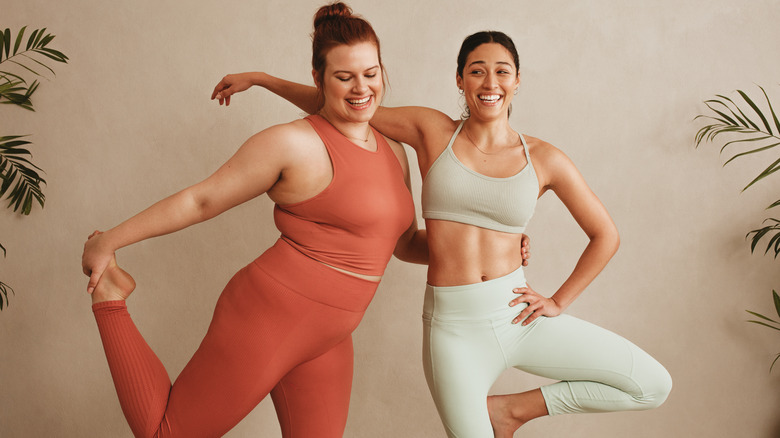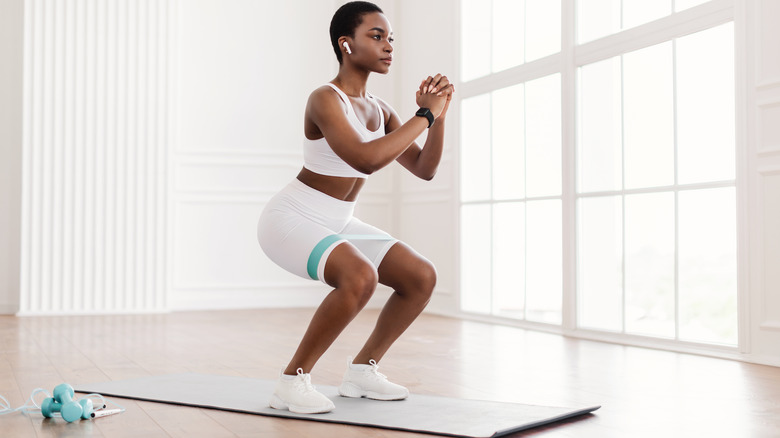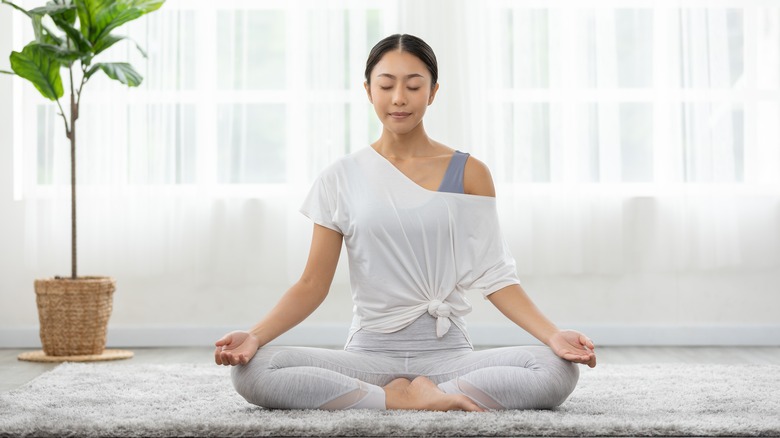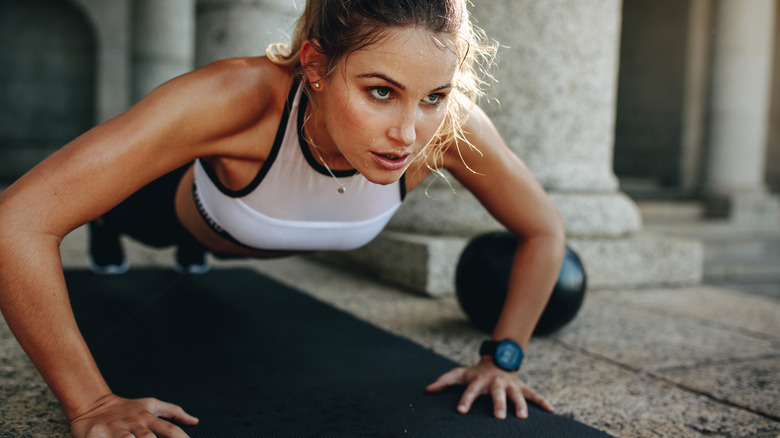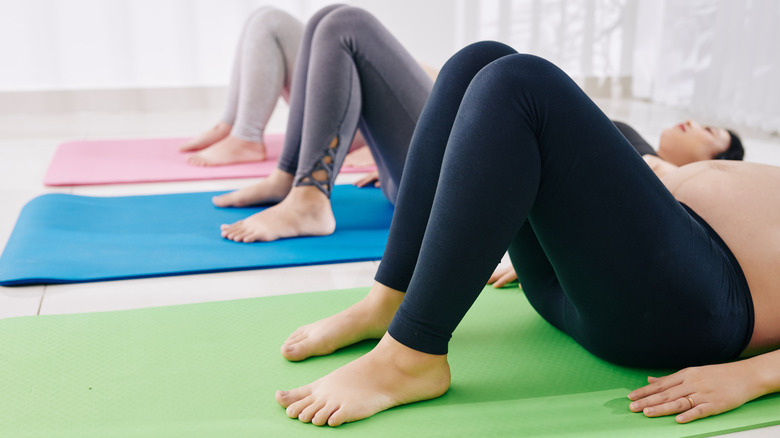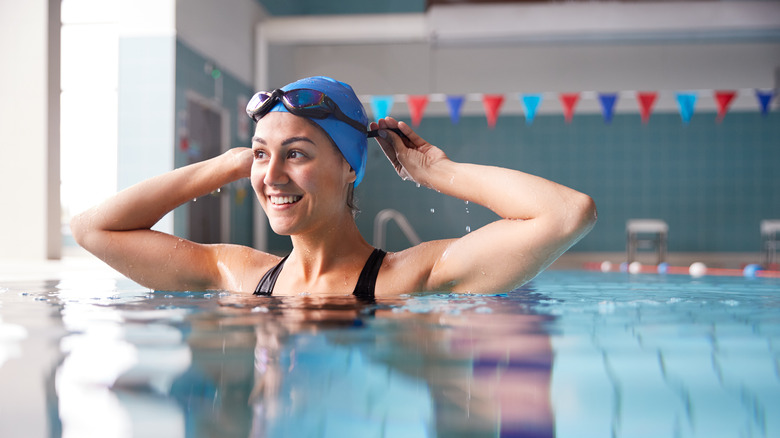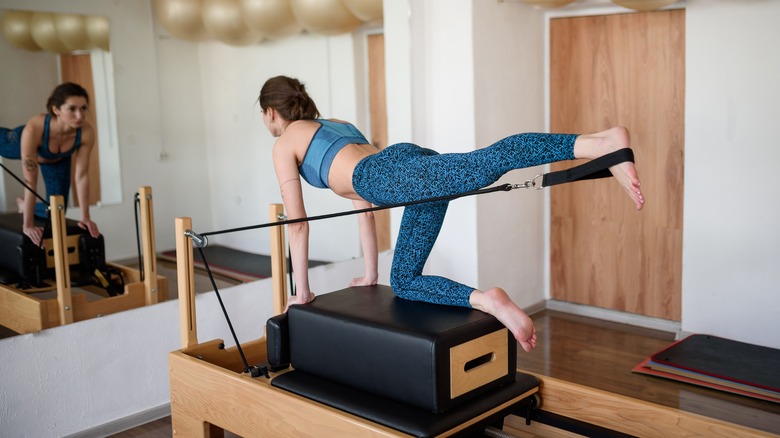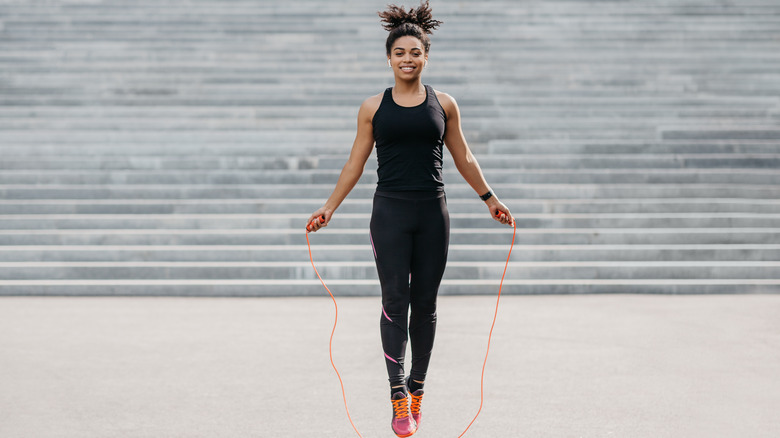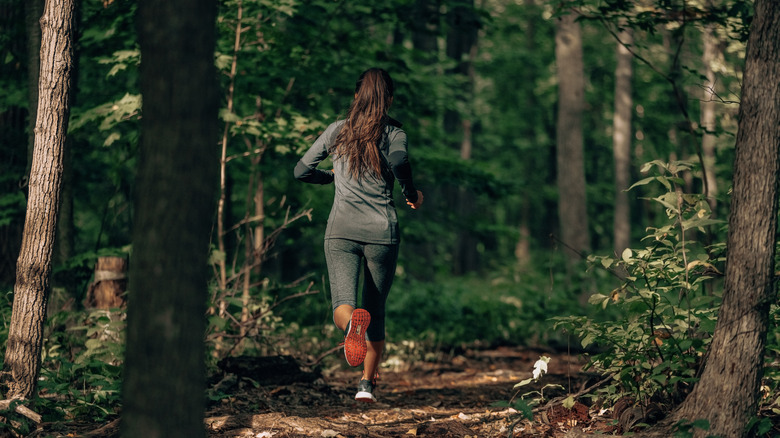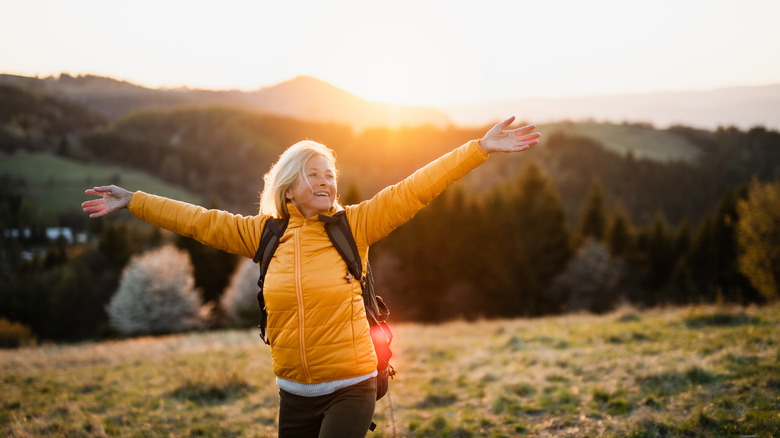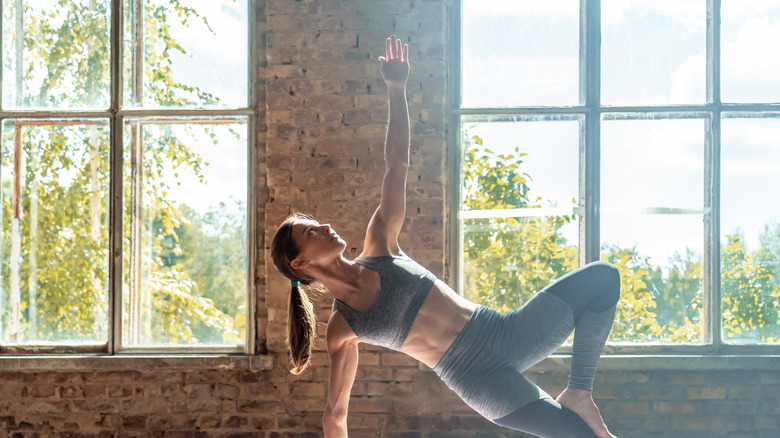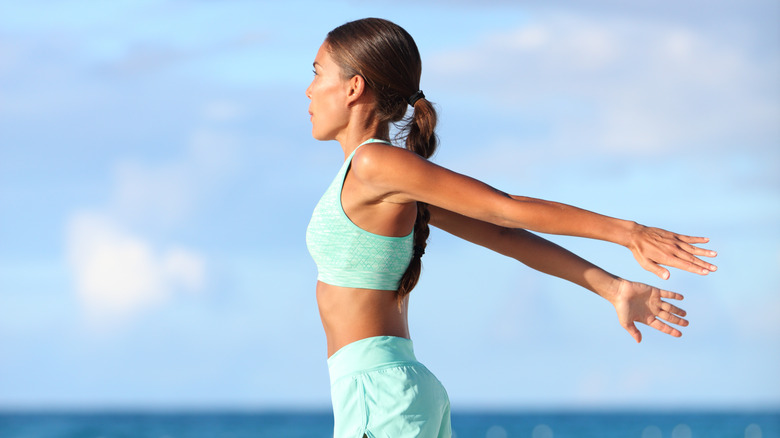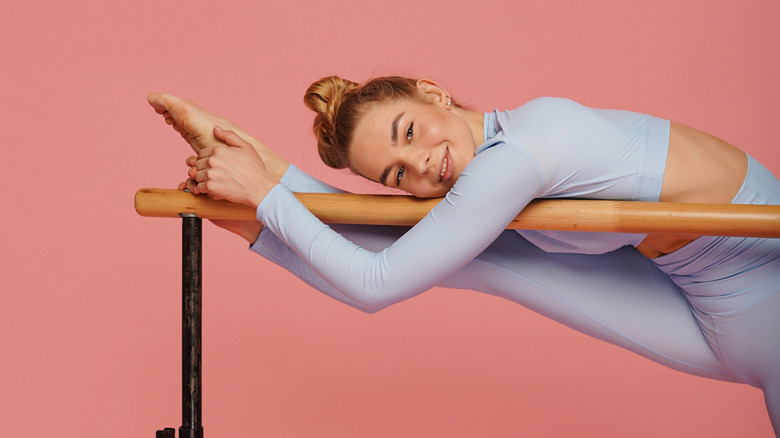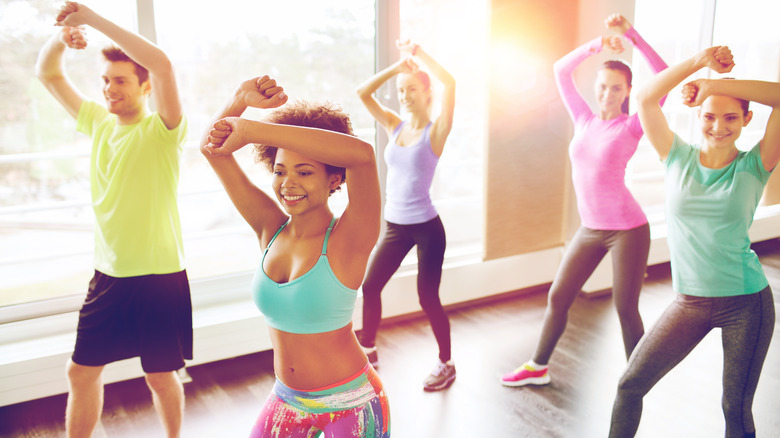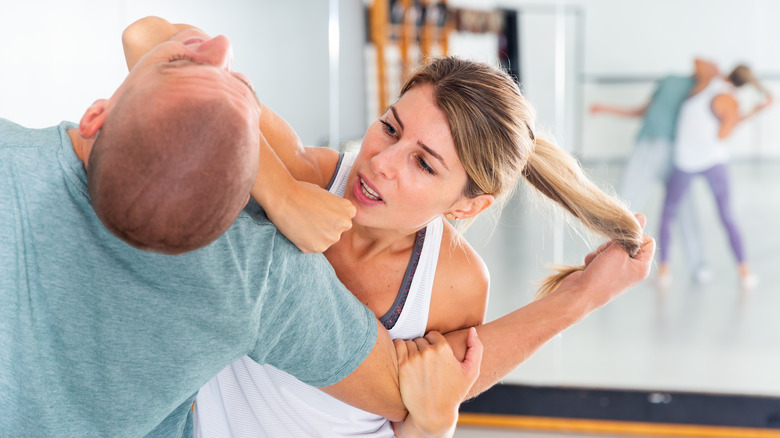Exercises Every Woman Needs In Her Fitness Routine
It's no secret that working out is one of many keys to living a long, healthy, and happy life. Exercise has been linked to boosts in mood, energy, general health, and even better sex according to experts at Mayo Clinic. To reap the most benefits from exercise, the site recommends getting in at least 150 minutes of "moderate aerobic activity" or a minimum of 75 minutes of "vigorous aerobic activity" per week. While the importance of exercise for both men and women can't be denied, there are differences between the sexes that may play a role.
Women face unique health challenges such as being at a higher risk for osteoporosis, certain types of cancers, as well as being at a higher risk for mental health disorders such as depression and anxiety (via Regis College). Furthermore, for women who want to get pregnant, moderate workouts have been shown to increase fertility levels across the board. Developing a workout regimen to ensure you stay healthy enough to ward off disease is an important and valuable part of any woman's routine. If you're curious about what workouts to incorporate into your weekly 150 allotment, continue reading.
Squats
Having a firm, round, and lifted rear end has become one of the latest fitness crazes (via The Guardian). Having a toned derriere has a way of making certain outfits — well, pop — and it can be easily achieved through a commitment to one time-tested workout: the squat. To answer the question on everyone's mind — "will squats really make my butt look better?" – experts at Byrdie weighed and in answered with a resounding yes. Cue that sigh of relief.
Sarah Rector, a personal trainer at The SLR Life spoke to the site and explained, "Squats help with strengthening the muscles as well as toning the hamstrings and glutes. It's like anything: The more regularly you do squats, the more results you will see." As far as how often to do them, Rector recommends starting out with 20 squats a day, and adding more to your routine gradually. Additionally, it's recommended to rest between 24 and 48 hours between squat sessions to give your body adequate time to rest. Not only does this prevent you from getting bored with your routine, but the recovery time is also key to help build muscle. When starting out with squats, be sure to double check your form to avoid injury.
Yoga
Yoga is one of those exercises that on the surface might not seem that impactful, but the after-effects tend to reveal an entirely different story. One of the most notable benefits of yoga is its calming effect, which can be incredibly beneficial for women who struggle with stress and anxiety. According to the Anxiety & Depression Association of America, women are twice as likely as men to be diagnosed with an anxiety disorder. The good news is that yoga has been scientifically proven to help reduce said stress.
MoreYoga instructor Anna de Sousa spoke to Women's Health and explained that excess stress causes our bodies to tense up, as well as our minds. This stress leads the nervous system to activate the fight-or-flight response, which then triggers adrenaline, the production of cortisol, and then an increase in our heart rate. "Yoga helps us tune in with our rest and digest nervous system response, instead. Our body starts its recovery, restore and repair functions," she explains to Women's Health. Furthermore, a study published by the Journal of Alternative and Complementary Medicine showed that yoga is also beneficial for reducing depression, and is in fact one of the best exercises for increasing the hormone GABA, which is responsible for regulating mood (via Boston University).
Pushups
For some women, plastic surgery may seem like an extreme, or simply out-of-reach way to modify the appearance of their chest. However, if you're after a simple lift — and possibly even make them look bigger — there are certain exercises you can integrate into your routine that help do the trick. Jen Comas Keck, a certified personal trainer and former figure competitor, spoke to Women's Health and explained that "Developing the muscles underneath your breasts will enhance the look of your breasts and make them appear larger." Sounds good, right?
To reach peak perkiness, Keck curated a series of upper body exercises, including pushups, to help better shape the chest. She explained to the magazine that workouts like pushups, combined with other moves like the dumbbell bench press, can contribute to a "beautiful shape on the chest." Nicholas Poulin, trainer and founder of Poulin Health and Wellness, spoke to Well + Good and seconded this notion about the value of push ups, explaining that "Wide push-ups are optimal, as the wider position has more of an effect on the chest."
Kegels
You may have heard of Kegel exercises before and wondered what exactly they were and how they could help you. While yes, this exercise has been primarily embraced by women, it is actually suitable for all people as it helps to strengthen the pelvic floor muscles, which both men and women have. Healthline explains that the pelvic floor muscles are made up of both muscles and connective tissues that attach to your pelvis. The pelvic floor includes the "urethra, bladder, intestines, and rectum," as well as the "uterus, cervix, and vagina" (in people who have those organs). These muscles are important to daily functions including urinating, walking, as well as arousal and orgasm, according to the site.
For women, strengthening the pelvic floor muscles can be especially important as pregnancy and vaginal delivery can cause these muscles to weaken and lead to discomfort, pain, and even the prolapse of your pelvic organ. According to Healthline, Kegel exercises require you to quickly contract the muscles in your pelvic floor, which both activates and strengthens them. To do this exercise, start by laying down on the floor with your knees bent and feet flat on the ground. Next, draw your navel into your spine, and then quickly tighten and release the pelvic floor muscles (these are the ones that control urination, so to figure out where they are and how to contract them, sit on the toilet and stop urinating mid-flow, per MedlinePlus). Repeat with one second between each contraction.
Swimming
Swimming may not be the first workout you think of incorporating into your routine when trying to get fit, but perhaps it should be. It brings with it a wealth of benefits including improved mental health, better sleep, and is also a low-impact sport that can be safe for pregnant women. Fitness experts spoke to Women's Health UK and dove into the science behind why swimming is so good for you.
Emily Morrissey, a swimming instructor, started out by extolling its benefits for mental health. She said, "Many people say that by simply being in the water they feel more relaxed and less stressed. Regular exercise helps reduce anxiety and depression, as it releases 'feel-good' hormones and keeps our brains working in a healthy way." Furthermore, finding a picturesque pool outdoors can help contribute to feelings of calm and create positive memories, Morrissey explains.
As mentioned, swimming is also a low-impact sport. This is because water naturally holds your body weight and reduces the "stress and impact" your joints might experience in a workout like running. For women who are pregnant, the low-impact nature of swimming makes it an excellent exercise, as it supports your body weight and creates limited stress on your potentially overworked feet and ankles.
Pilates
If group fitness classes are more your speed, signing up for a Pilates session may be just what the doctor ordered. Some of the results you might see after committing to Pilates include a longer and more toned physique, increased flexibility, and a stronger core, according to Women's Health. Marina Kaydanova, founder of BK Pilates in New York City, spoke to the publication and explained that if you're feeling tightly wound, Pilates has a special way of loosening you up: "Oftentimes, people feel that their body has been compressed, tense, and tight beforehand but leave the studio feeling more loose and more aware of their body."
For those of you who want to strengthen your core, Pilates can do that for you as well. Because Pilates requires you to maintain proper alignment and balance, the core muscles are consistently engaged, which helps to strengthen those muscles. Furthermore, a study published by Musculoskeletal Care found that Pilates can actually help ease aches and pains. It followed a group of 22 adults with musculoskeletal conditions and found that after practicing Pilates regularly, the participants were able to better manage their conditions.
Jumping rope
If you thought jumping rope was solely an activity from your bygone childhood era, think again. Jumping rope is actually a powerhouse cardio activity that many professional athletes use to train for their sports, according to experts at Women's Health. For instance, William Roberts, director of the Sports Medicine Program at the University of Minnesota Medical School, explained that "[Boxers have] used it for a long time for strength, balance, and cardiovascular exercise."
There are many reasons to add jumping rope to your repertoire of fitness activities, starting with the fact that it's actually great for your skeletal system — a particular concern for women, who become more vulnerable to osteoporosis and broken bones as they age (via the Office on Women's Health). Because it is a "load-bearing" exercise, which means you have to put weight on your skeleton, it can help improve your bone health. Heather Milton, an exercise physiologist at NYU Langone's Sports Performance Center, explained to Women's Health that it can be particularly useful for young girls: "Especially for female youth, we want to encourage activities like this during puberty to peak bone density, as it is much harder to increase bone density after the age of twenty." On the flipside, it's also proven to be beneficial for the bone health of post-menopausal women too.
Running
Running is one of the easiest and most convenient ways to get in some exercise (via The Irish Times), and its benefits are varied and essentially endless. Whether you are new to running or have been doing it for some time, knowing how it benefits you may give you that extra motivation you need to make it a consistent habit. Women's Health spoke to several fitness experts to get the scoop on running and uncovered several key benefits.
For starters, running drastically reduces your risk of heart disease. According to the Centers for Disease Control and Prevention (CDC), heart disease is the number one cause of death for women in the U.S., having accounted for one out of every five deaths in 2017. However, Women's Health cites a study published by the Journal of the American College of Cardiology that says running cuts down the risk of heart disease by 45%. It does this by improving blood pressure, improving good cholesterol, and helping to manage blood sugar, according to Janet Hamilton, an exercise physiologist at Running Strong in Atlanta (via Women's Health). Furthermore, if you struggle with memory issues, running also helps with the process of neurogenesis, or the process of creating new brain cells. Over time this can help the hippocampus, which is the part of the brain that is responsible for learning and memory.
Walking
If you are new to exercise or just want to find a workout that's on the more relaxing side, walking may be right up your alley. A few of the many benefits of walking include reduced blood pressure, improved heart health, and a reduced risk of chronic disease, according to Prevention. Fitness expert Denise Austin spoke to the site and explained, "It has tremendous benefits, from supporting a healthy immune system to boosting your metabolism to strengthening your joints, muscles, and bones — not to mention it's amazing for stress relief and enjoying a little 'me time.'"
In more good news, the effects of walking have been proven to make people more ... easy to be around. Melina B. Jampolis, author of "The Doctor on Demand Diet" explained to Prevention that keeping up with regular walking can improve your nervous system and help promote a "decrease in anger and hostility." These benefits are boosted further by taking a walk outside in the sunshine, or being joined by a walking buddy. If losing weight is in your plans, walking is a surefire way to do it. Experts at the site say the activity can help increase your metabolism, thus helping you to burn fat. To boost its calorie-burning effects, try walking up hills and alternating between speed walking and normal walking.
Plank pose
Although from the outside doing a plank may not look too complicated, it's another exercise that's working hard behind the scenes to deliver results. According to Healthline, planking is perhaps one of the more underrated core exercises, but is nonetheless very effective at helping to strengthen your core and improve its stability. As the site explains, getting into the position is the easy part — maintaining it for any length of time is where the hard work comes in.
Experts at the site go as far as to say that planking is actually better for your core muscles than doing situps, in that it requires you to use your whole body. Your arms, legs, and all of your abdominals are required in order to maintain plank position, making it an incredibly well-rounded exercise. Variations of planks include high plank, which requires you to start in a pushup position with your palms and toes on the ground and your back straight. A low plank, however, is an easier modification which allows you to place your forearms on the ground.
Burpees
Burpees are famed for being both highly effective and highly challenging. However, for those who invest their time in learning how to do them, be prepared for major payoffs. Alexis Dreiss, a certified personal trainer and functional strength coach, spoke to Women's Health and explained, "Burpees are a total-body movement. You work through a hip hinge, knee [movement], and pushing motion all in one. You're getting a true bang for your buck." Dreiss adds that beyond strength training, burpees are actually an aerobic activity, and are classified as a high intensity interval training (HIIT) workout, which provide many health benefits. Be aware, however, that if you haven't hit the gym in a while, you may want to start out with some lower impact exercises before you head straight for burpees.
If you are ready, Women's Health says to stand up with your feet spread hip-distance apart. Bend down at the hip and place your hands on the ground outside of your feet, and shoot your legs backward into high plank. Engage your core muscles and lower yourself into a pushup position. As you rise up out of the pushup, jump forward and place your feet between your hands in the squat position. Rise to standing, and repeat.
Barre
A fusion of yoga, Pilates, and ballet, barre is a relatively new introduction to the fitness world that offers many health benefits as well as the promise of a more toned and svelte body. Healthline explains that this activity can contribute to an overall improvement in your health, help with weight management, and strengthen your body. If you're already familiar with ballet, there may not be much of a learning curve to do the pliés and relevés included in barre class. While subtle, these movements — called isometric movements — work to "flex" the muscles without contracting or expanding them. Mayo Clinic explains that these types of exercises are great for building strength and enhancing stabilization.
Healthline reports that barre is especially good for strengthening the "core, arms, thighs, glutes, and pelvic floor," as well as improving your overall muscular endurance. Furthermore, because the class requires a lot of stretching, both your flexibility and range of motion are bound to increase. For women who are concerned about osteoporosis, the good news is that practicing barre regularly can help improve bone density, which can help prevent the onset of osteoporosis. If you're worried about needing to find the perfect studio to start barre, Healthline explains that it can be done from the comfort of your own home using a chair to stabilize, as well as a yoga mat.
Zumba
You may have walked past a Zumba class in your gym, observed all the ramped-up energy, loud music, and commotion, and wondered to yourself, "what is that ... and how soon can I start?" Well, now there's no more need for you to miss out for lack of information. According to Healthline, Zumba is a type of full-body workout that is based on Latin American dance, and is accompanied by music — often of the loud variety. Basically, if your regular aerobics class has you bored and zoning out, swap if for Zumba and your problem will undoubtedly be solved. Zumba is a combination of both dance and aerobics, and according to Healthline "there's no right or wrong way" to do it, so if you have two left feet, don't worry. Furthermore, you can burn upward of 369 calories in a 39-minute Zumba class, which is in the ideal range for weight loss.
Lastly, if you're feeling a little bummed out or lonely in your workouts, Zumba is a group exercise, and as such creates a fun and social environment that may encourage you to want to hit the gym for classes more often.
Krav Maga
Whether you want to admit it or not, knowing how to defend yourself against a potential attacker is highly valuable skill to have in today's world. Unforunately, UN Women reports that one in three women have experienced "physical and/or sexual intimate partner violence, non-partner sexual violence, or both at least once in their life." Having self-defense skills in your back pocket may help you feel safer in vulnerable situations, and boost your sense of confidence.
According to Verywell Fit, Krava Maga is the self-defense system that the Israeli Army uses, and it incorporates moves that were developed to be easy to learn, do, and remember. Krav Maga fits into the category of martial arts, and was also designed to be suitable for every gender, age, size, fitness level, and athletic ability, according to the site. It relies heavily on repetition and muscle memory, and can also be utilized as a powerful full-body workout for those who want to increase their heart rates and burn some calories. Some of the basic moves of Krav Maga include the "home base" stance — in which the defender stands with their feet shoulder-width apart, one foot stepped forward (the opposite foot from their dominant hand), and hands in front of their face — in addition to the knee strike, the palm-heel strike, and the front kick.
If you or someone you know is dealing with domestic abuse or has been a victim of sexual assault, help is available. You can call the National Domestic Violence Hotline at 1−800−799−7233 and find more information, resources, and support at their website; or visit the Rape, Abuse & Incest National Network website or contact RAINN's National Helpline at 1-800-656-HOPE (4673).

